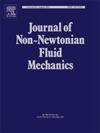Thermo-hydraulic perspectives of non-Newtonian channel flow with active flow modulation: A CFD study
IF 2.7
2区 工程技术
Q2 MECHANICS
引用次数: 0
Abstract
This study aims to numerically explore the influence of active flow modulators on thermo-hydraulic characteristics of channel flow with non-Newtonian power-law fluid, also known as Generalized Newtonian Fluid (GNF). The upper and lower walls of the channel under consideration are heated isothermally, while at the inlet a channel flow with Poiseuille fluid flow profile is imposed, influenced by an active flow modulator, namely an oscillating blade positioned along the channel centreline. Within the Arbitrary Lagrangian-Eulerian framework, the associated flow and thermal fields are solved using the Galerkin finite element method. The channel's hydrodynamic state is assessed in relation to the Reynolds number variation (50 ≤ Re ≤ 150), for various non-Newtonian fluids as represented by the power-law index variation (0.6 ≤ n ≤ 1.2). Furthermore, the corresponding dimensionless oscillating frequency (N*) and channel blockage ratio (B) are changed in order to investigate the impact of the flow modulator. The evolution of temperature and flow fields as well as heat transfer performance metrics, such as local, spatially and time averaged Nusselt numbers, have all been taken into consideration while evaluating the characteristics of the system. The obtained results indicate that the Reynolds number and associated flow obstruction have a significant impact on the flow modulator's efficacy. For pseudoplastic fluids (n = 0.6), thermal oscillations can be observed, which are brought on by the oscillating modulator's periodic shedding of vortices. While pseudoplastic fluid might improve heat transfer, especially at greater blockage ratios, the situation is reversed when the associated pressure drop is taken into account.
具有主动流动调制的非牛顿通道流动的热水力视角:CFD研究
本研究旨在数值探讨主动流量调节器对非牛顿幂律流体(也称为广义牛顿流体(GNF))通道流热水力特性的影响。所考虑的通道的上下壁被等温加热,而在入口处,受主动流量调节器(即沿通道中心线放置的振荡叶片)的影响,施加具有泊泽维尔流体流动剖面的通道流动。在任意拉格朗日-欧拉框架下,用伽辽金有限元法求解了相关的流场和热场。对于幂律指数变化(0.6≤n≤1.2)所表示的各种非牛顿流体,通道的水动力状态与雷诺数变化(50≤Re≤150)有关。此外,通过改变相应的无量纲振荡频率(N*)和通道阻塞比(B)来研究流量调制器的影响。在评价系统特性时,考虑了温度场和流场的演变以及局部、空间和时间平均努塞尔数等传热性能指标。结果表明,雷诺数和相关的流阻对流动调节器的效果有显著影响。对于假塑性流体(n = 0.6),可以观察到热振荡,这是由振荡调制器周期性的涡脱落引起的。虽然假塑性流体可能会改善传热,特别是在较大的堵塞比下,但当考虑到相关的压降时,情况正好相反。
本文章由计算机程序翻译,如有差异,请以英文原文为准。
求助全文
约1分钟内获得全文
求助全文
来源期刊
CiteScore
5.00
自引率
19.40%
发文量
109
审稿时长
61 days
期刊介绍:
The Journal of Non-Newtonian Fluid Mechanics publishes research on flowing soft matter systems. Submissions in all areas of flowing complex fluids are welcomed, including polymer melts and solutions, suspensions, colloids, surfactant solutions, biological fluids, gels, liquid crystals and granular materials. Flow problems relevant to microfluidics, lab-on-a-chip, nanofluidics, biological flows, geophysical flows, industrial processes and other applications are of interest.
Subjects considered suitable for the journal include the following (not necessarily in order of importance):
Theoretical, computational and experimental studies of naturally or technologically relevant flow problems where the non-Newtonian nature of the fluid is important in determining the character of the flow. We seek in particular studies that lend mechanistic insight into flow behavior in complex fluids or highlight flow phenomena unique to complex fluids. Examples include
Instabilities, unsteady and turbulent or chaotic flow characteristics in non-Newtonian fluids,
Multiphase flows involving complex fluids,
Problems involving transport phenomena such as heat and mass transfer and mixing, to the extent that the non-Newtonian flow behavior is central to the transport phenomena,
Novel flow situations that suggest the need for further theoretical study,
Practical situations of flow that are in need of systematic theoretical and experimental research. Such issues and developments commonly arise, for example, in the polymer processing, petroleum, pharmaceutical, biomedical and consumer product industries.

 求助内容:
求助内容: 应助结果提醒方式:
应助结果提醒方式:


